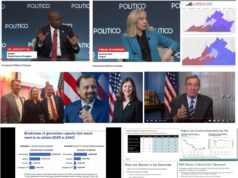by Morris Meyer
This post is about politics and clean energy. As utility regulation is complex, hopefully this will shed some light on what is happening with respect to clean energy in Virginia from the federal level.
This Thursday the Federal Energy Regulatory Commission (FERC) finalized a rule making that would impact the power market serving Virginia.
Virginia’s electrical energy needs are serviced by Dominion Energy, Appalachian Power, Kentucky Utilities, a few dozen electrical co-ops, and a dozen municipal utilities.
Beyond Virginia, these utilities are part of a 13-state utility interconnection called the PJM (from Pennsylvania to New Jersey to Maryland). There is a very small part of southwest Virginia that is outside the PJM, but almost all of our state’s power load needs are contained within the PJM. Transmission of electrical energy across state borders is handled by regional transmission organizations (RTOs), with PJM being the largest RTO.
FERC’s December 19 press release on the Minimum Offer Price Rule (MOPR) is here (“FERC Directs PJM to Expand Minimum Offer Price Rule”). It concerns the Capacity Market of the PJM and the fate of renewable energy offering firm power commitments as load-serving entities into the PJM.
Before getting into the specifics of the rule, a look at the PJM electricity market is necessary. Delivery to power markets is driven by Locational Marginal Pricing (LMP), a term that indicates how power companies that deliver to electricity substations are paid. The LMP is driven by the stack of power producers, each with their own price of delivering power. The LMP is driven by the merit order effect, which stacks power from lowest fuel cost to highest fuel cost for that substation energy service.
Power commitments are stacked from lowest cost to highest cost. The cost of an additional megawatt of electricity from the highest cost producer is the LMP and is used as the cost paid to all of the power producers from lowest to highest.
Given that more renewable energy is built out in the PJM states, these prices go in at the bottom of the merit order stack, and as a result renewables are displacing more expensive generation.
As a new Star Wars movie is opening this weekend, a description of the “dark side of the force” probably isn’t necessary. Suffice it to say that the current FERC chairman, Neil Chatterjee, worked as energy policy advisor for Senator Mitch (R-Palpatine, coal) McConnell. Need I say more?
Energy and climate Twitter has described the mendacity that this ruling attempts to promote. For instance:
- “Choosing not to mitigate federal subsidies (i.e. tax credits) because it finds FERC ‘may not disregard or nullify the effects of federal legislation,’ while ignoring whether it has authority to “disregard or nullify” state clean energy programs.”
- “Not denying the obvious — that the MOPR will raise consumer costs — but entirely ignoring those costs and making no effort to estimate those costs.”
- “Claiming the order does not ‘change the purpose of the MOPR, but only changes its scope’ when the MOPR was initially designed to prevent market power abuse, a task at the heart of FERC’s authority, and it is now designed to block state-supported resources.”
- “Failing to acknowledge that PJM’s procurement through the capacity auction no longer has any connection to resource adequacy or reliability.”
The sole Democratic FERC commissioner added:
In a scathing dissent during Thursday’s meeting, Glick accused Republican FERC Chairman Neil Chatterjee and Commissioner Bernard McNamee of “nullifying state policies” with the order. “What we’re doing here — and we’re doing it on purpose — is making it very difficult for state-preferred resources to clear in the capacity market,” he said.
What’s more, the new order’s expanded definition of “state subsidy” could force a MOPR onto a broad class of resources yet to be built, he said. That includes all new generators built by municipal and cooperative utilities, which “blows up the business model” for these public power entities, and potentially all generators in states participating in the Regional Greenhouse Gas Initiative, he said.
Not surprisingly, Senate Minority Leader Chuck Schumer has come out against this rule.
“Why is the Federal Energy Regulatory Commission trying to make renewable sources of energy more expensive for Americans in our largest power grid? This is unacceptable. This is not how to fight the climate crisis. We will fight this.”
Astoundingly, if the FERC Republicans get their way here, mandatory renewable portfolio standards (RPS) programs and RGGI will be considered as state subsidies. And any legislation around a new RPS standard is in peril with this new MOPR ruling.
In general, the wrongness of this ruling can be found in distorting the market price for electricity toward incumbent (aka, fossil fuel) producers, with a detrimental affect on ratepayers. Not surprisingly for Trump and Mitch McConnell’s FERC, disadvantaging new renewable energy through state legislative efforts seems to be the intent of this ruling.
How absurd is this? Consider that:
- The market price for Q3 2019 solar power purchase agreements in the PJM market is $32.30/megawatt-hour (MWh).
- The Dominion 2018 Integrated Resource Plan (IRP) lists generation assets in table 5.5.4.3, with solar at $56.38 per MWh. Notably, Dominion considers utility-scale solar power the cheapest form of new generation.
- Appendix 4A of the Dominion 2018 IRP lists the ICF Commoditized Forecasts for Virginia Electric and Power Company (Dominion). PJM-DOM pricing for On Peak ($/MWh) power is $38.33.
- The FERC is proposing to consider it a state subsidy to mandate renewable energy, even considering that the solar power contracts are lower than peak power energy delivered contracts on the PJM. Solar with storage PPAs that put firm delivery in peak pricing months of June through September during the 5 pm-8 pm hours is price competitive on the PJM. Solar generation is the energy, and battery storage becomes the fuel in the merit order stack that allows solar to shift further toward peak pricing, and to fairly compete in evening hours.
Attorney General Mark Herring, as well as Senators Mark Warner and Tim Kaine, should consider this MOPR ruling an affront to lowering consumer prices for electricity and bringing new clean sources onto the grid. And Governor Northam’s clean energy vision for 2050 through regional partnerships and a decarbonization transition is imperiled by this ruling. The Virginia Clean Energy Act that utilizes the Regional Greenhouse Gas Initiative (RGGI) is also considered a state subsidy for new entries under the MOPR ruling. And Virginia Green New Deal legislation might fall under the MOPR rule as well.
The PJM has a 90-day window to respond to this ruling. Considering the Virginia legislative session runs from January 8 to March 7, 2020, this is all hands on deck for Virginia to fight FERC’s ridiculous new rule making.













![Video: Sen. Mark Warner Says Last Night, “you saw an angry old man [Trump] giving a partisan screech that doesn’t solve anything”](https://bluevirginia.us/wp-content/uploads/2025/12/warner1218-100x75.jpg)

